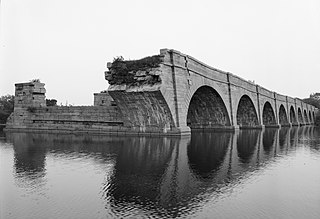Related Research Articles

The Erie Canal is a historic canal in upstate New York that runs east–west between the Hudson River and Lake Erie. Completed in 1825, the canal was the first navigable waterway connecting the Atlantic Ocean to the Great Lakes, vastly reducing the costs of transporting people and goods across the Appalachians. The Erie Canal accelerated the settlement of the Great Lakes region, the westward expansion of the United States, and the economic ascendancy of New York state. It has been called "The Nation's First Superhighway."

DeWitt Clinton was an American politician and naturalist. He served as a United States senator, as the mayor of New York City, and as the seventh and ninth governor of New York. In the last capacity, he was largely responsible for the construction of the Erie Canal. Clinton was a major candidate for the American presidency in the election of 1812, challenging incumbent James Madison.

Macedon is a town in Wayne County, New York, United States. The population was 9,148 at the 2010 census.

William Christian Bouck was an American politician from New York. He was the 13th Governor of New York, from 1843 to 1844.

The Ohio and Erie Canal was a canal constructed during the 1820s and early 1830s in Ohio. It connected Akron with the Cuyahoga River near its outlet on Lake Erie in Cleveland, and a few years later, with the Ohio River near Portsmouth. It also had connections to other canal systems in Pennsylvania.

The New York State Canal System is a successor to the Erie Canal and other canals within New York. The 525-mile (845 km) system is composed of the Erie Canal, the Oswego Canal, the Cayuga–Seneca Canal, and the Champlain Canal. In 2014 the entire system was listed as a national historic district on the National Register of Historic Places, and in 2016 it was designated a National Historic Landmark.

PSINet, formerly Performance Systems International, was an American internet service provider based in Northern Virginia. As one of the first commercial Internet service providers (ISPs), it was involved in the commercialization of the Internet until the company's bankruptcy in 2001 during the dot-com bubble and acquisition by Cogent Communications in 2002.

The Champlain Canal is a 60-mile (97 km) canal in New York that connects the Hudson River to the south end of Lake Champlain. It was simultaneously constructed with the Erie Canal for use by commercial vessels, fully opening in 1823. Today, it is mostly used by recreational boaters as part of the New York State Canal System and Lakes to Locks Passage.

The New York State Department of Transportation (NYSDOT) is the department of the New York state government responsible for the development and operation of highways, railroads, mass transit systems, ports, waterways and aviation facilities in the U.S. state of New York.
The Commission to Explore a Route for a Canal to Lake Erie and Report, known as the Erie Canal Commission, was a body created by the New York State Legislature in 1810 to plan the Erie Canal. In 1817 a Canal Fund led by Commissioners of the Canal Fund was established to oversee the funding of construction of the canal. In 1826 a Canal Board, of which both the planning commissioners and the Canal Fund commissioners were members, was created to take control of the operational canal. The term "Canal Commission" was at times applied to any of these bodies. Afterwards the canal commissioners were minor state cabinet officers responsible for the maintenance and improvements of the state's canals.
The Center for Computational Innovations (CCI), is a supercomputing center located at the Rensselaer Technology Park in Troy, New York.

The Old Erie Canal State Historic Park encompasses a 36-mile (58 km) linear segment of the original Erie Canal's Long Level section. It extends westward from Butternut Creek in the town of DeWitt, just east of Syracuse, to the outskirts of Rome, New York. The park includes restored segments of the canal's waterway and towpath which were in active use between 1825 and 1917. It is part of the New York State Park system.

The Erie Canal Museum is a historical museum about the Erie Canal located in Syracuse, New York. The museum was founded in 1962 and is a private, non-profit corporation. It is housed in the Syracuse Weighlock Building dating from 1850. The Syracuse Weighlock Building was in operation as a weighlock from 1850 to 1883. In 1883 the canal decided to stop charging tolls. The weighlock building was essentially used as a big, elaborate scale to weigh the boats traveling on the Erie Canal and determine how much each boat would pay for a toll. Today the museum includes not only artifacts from the Erie Canal, but also a gallery of present canal life. It is the mission of the museum to help people to learn the rich history of the Erie Canal and that it is not just a thing of the past, but still very much exists today in different forms.

The Genesee Valley Greenway is a rail trail in western New York's Genesee River valley.
Transportation in New York is made up of some of the most extensive and one of the oldest transportation infrastructures in the country. Engineering difficulties because of the terrain of the State of New York and the unique issues of New York City brought on by urban crowding have had to be overcome since the state was young. Population expansion of the state generally followed the path of the early waterways, first the Hudson River and then the Erie Canal. Today, railroad lines and the New York State Thruway follow the same general route.

Schoharie Crossing State Historic Site, also known as Erie Canal National Historic Landmark, is a historic district that includes the ruins of the Erie Canal aqueduct over Schoharie Creek, and a 3.5-mile (5.6 km) long part of the Erie Canal, in the towns of Glen and Florida within Montgomery County, New York. It was the first part of the old canal to be designated a National Historic Landmark, prior to the designation of the entire New York State Barge Canal as an NHL in 2017.

The Beaver and Erie Canal, also known as the Erie Extension Canal, was part of the Pennsylvania Canal system and consisted of three sections: the Beaver Division, the Shenango Division, and the Conneaut Division. The canal ran 136 miles (219 km) north–south near the western edge of the state from the Ohio River to Lake Erie through Beaver County, Lawrence County, Mercer County, Crawford County, and Erie County, Pennsylvania.

The New York State Canalway Trail is a network of multi-use trails that runs parallel to current or former sections of the Erie, Oswego, Cayuga-Seneca, and Champlain canals. When completed, the system will have 524 miles (843 km) of trails following current and former sections of the canals. The longest of these is the 365 miles (587 km) long Erie Canalway Trail. The Erie and Champlain Canalway Trails are also part of the statewide Empire State Trail system.
The following is a timeline of the history of the city of Buffalo, New York, United States.

Geraldine MacDonald is an American internet and online services pioneer, best known for building and operating the world's largest dial-up network for America Online supporting over 35 million customers at its peak.
References
- ↑ "Erie Canal: Living Link to Our Past". National Geographic. November 1990. p. 46.